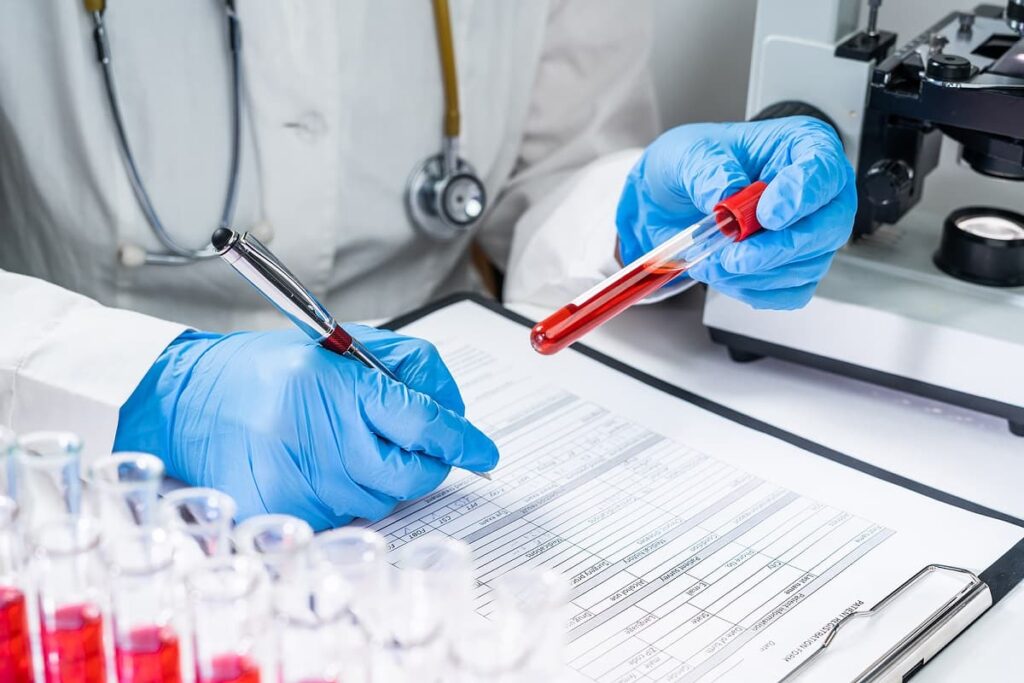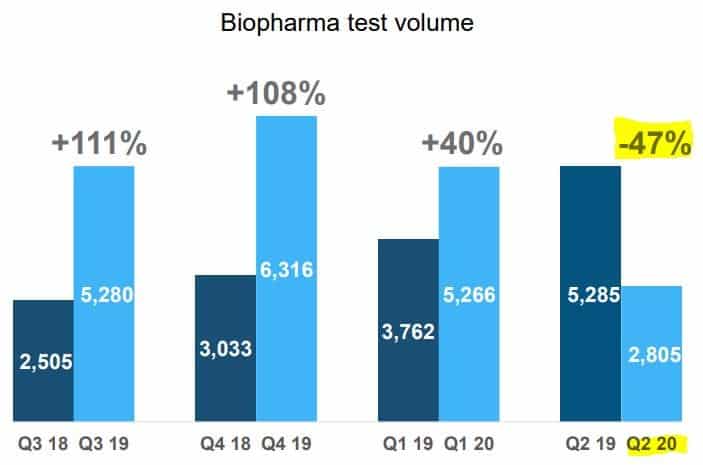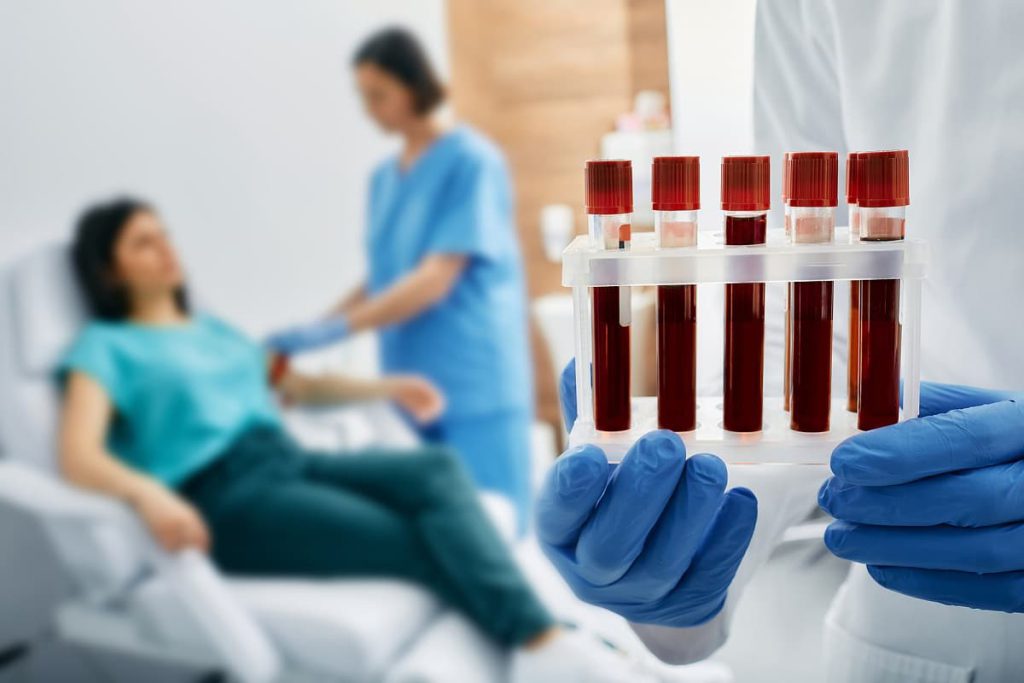A Liquid Biopsy Stock That’s Going Places
Table of contents
Table of contents

The so-called “cure for cancer” isn’t one magical treatment that may or may not be secretly hidden from everyone as part of a vast conspiracy by big pharma. Today’s spray-and-pray approach to cancer treatment has varying degrees of success targeting the over 200 types of cancer, each instance of which is unique to the patient. The cure for cancer will come in two forms: early detection and precision oncology. An example of the former would be the introduction of the Pap smear which reduced cervical cancer mortality by more than 80% from 1950 to 2005.
Also referred to as “personalized medicine,” precision oncology starts with taking a genetic profile of a tumor and then figuring out what treatments will be most effective based on what worked for others with a similar genetic profile or even other matching characteristics. One company leading the charge in precision oncology is Guardant Health (GH).
About Guardant Health
Founded in 2012, San Francisco’s own Guardant Health went from an idea to a $9 billion company in just eight years with backing from investors like SoftBank, T. Rowe Price, Khosla, and Sequoia. Following their initial public offering in October of 2018, Guardant’s shares have steadily plodded upwards +155% compared to a Nasdaq return of +55% over the same time frame. Since past performance is no indicator of future performance, we want to evaluate Guardant based on where they stand today and their future growth potential.
Over the past four years, Guardant’s revenues have grown at an astounding compound annual growth rate (CAGR) of +136%, from $25.25 million in 2016 to $214 million in 2019.

Let’s look at what Guardant is selling so much of.
The Guardant Health Platform
The first slide of Guardant’s investor deck describes their business in two words – liquid biopsy. While a traditional biopsy involves cutting off a piece of a tumor to have it analyzed in a lab, a liquid biopsy accomplishes the same thing using a simple blood draw. Traditional tissue biopsy-based tumor profiling is often invasive and has longer turnaround times, resulting to delays in starting treatment.
Guardant breaks down the total addressable market (TAM) for liquid biopsies into three segments which present a combined $51 billion opportunity. Let’s start with the smallest one – Guardant360 for advanced cancer patients.
Guardant360: $6 billion TAM

First launched in 2014, the Guardant360 test is the world’s leading liquid biopsy test based on the number of comprehensive liquid biopsy tests sold in 2018. It’s been used over 150,000 times by clinicians to help inform which therapy may be effective for advanced-stage cancer patients with solid tumors. The test is broadly covered by Medicare and many private payers, representing over 170 million lives. Just last month, the FDA approved Guardant for use across all solid tumor types – the first approval of its kind.
Patient Treatment – $4 billion TAM
The use case on the treatment side is quite simple. No need to perform any invasive biopsies. A simple blood test will accomplish the same thing in typically seven days or less total turn-around time. Once you have a genetic profile of someone’s unique cancer, you can then figure out which therapies are most successful against it.
While medical guidelines strongly support the genetic profiling of cancer tumors, adoption has lagged. One factor is insufficient tissue for biopsy, something that’s the case for as many as 30 percent of solid cancer patients. A liquid biopsy makes this impediment a non-issue.
Drug Development – $2 billion TAM
There’s also a use case on the drug development side. Around 66% of the solid tumor cancer drug pipeline in 2018 was for targeted therapies and immuno-oncology therapy agents, many of which are targeting a cancer with a specific molecular profile or biomarker. Biopharmaceutical companies are able to increase chances of a drug’s success in clinical trials by identifying and selecting patients whose cancer has the right molecular profile. This enables them to potentially require fewer patients for the trial and shorten the duration of late-stage clinical trials.
Lunar-1: $15 billion TAM
The American Cancer Society estimated that in 2016 there were approximately 15 million solid tumor cancer survivors. Guardant translates this into a TAM of approximately $15 billion (assuming an average price of $1,000 per test for each solid tumor cancer survivor.) Launched in 2018 for research use and in late 2019 for investigational use, the LUNAR-1 test will be used to detect “residual disease in the blood of cancer patients after surgery, and surveillance of patients who have completed curative cancer treatment to potentially detect recurrence at an earlier stage.”
If you’re a cancer survivor, you’re probably going to err on the side of caution and get tested as often as possible for any signs of recurrence. A simple blood test can put your mind at ease. Perhaps they’ll even administer it as a test you can take at home, something offered today for comprehensive STD tests – or so we’re told.
Lunar-2: $30 billion TAM
In the not-so-distant future, your smart toilet will detect the onset of cancer in your morning urine stream and get your smart fridge to sort you out with some personalized medicine – faster than two shakes of a lamb’s tail. Until then, we need a better alternative to the awkward examination techniques used today – think prostate exams and breast screenings. That’s why a blood test that can detect most types of cancer just might help encourage people to get screened more often.
Guardant Health vs. Exact Sciences
Guardant’s first use case for early detection is colorectal cancer, something that has shareholders of Exact Sciences (EXAS) quaking in their boots. That’s because Exact’s bread and butter is Cologuard, a colorectal screening test that you may have seen advertised on the telly if you live in ‘Murica. The ability to detect colorectal cancer in stool samples has turned Exact into an $11 billion company with nearly $900 million in 2019 revenues.
We wrote about Exact a few years back noting:
Exact Sciences has a total addressable market of around $14 billion, little competition, and soon one of the world’s largest pharmaceutical companies helping them to market their Cologuard tests. It’s no surprise the share price is soaring as a result.
Credit: Nanalyze
Shares of Exact are sitting right around where they were when we wrote the above piece, but the competitive environment has shifted a bit.
Guardant is currently recruiting around 10,000 patients for a study called ECLIPSE which will evaluate the performance of their LUNAR-2 assay in detecting colorectal cancer in average-risk adults. The study began in October of last year, and is recruiting patients at 118 locations (link to ECLIPSE study here).

In regards to how Exact Sciences perceives this threat, look no further than page 14 of their latest 10-K which talks about how they’re trying to improve the Cologuard test because, “If we could increase the specificity of Cologuard, we believe that would enhance its adoption as a front-line screening test.” The Guardant investor deck makes it a point to emphasize that they’ve solved this problem using epigenomic signatures.

The Exact Sciences 10-K then goes on to talk about their own study, BLUE-C, which is determining if the new and improved Cologuard test can detect early prostate cancer in a 12,500-patient study at 65 locations that’s expected to be complete by the end of this year (link to BLUE-C study here). The company goes on to say:
The timing of any such enhancements to Cologuard is unknown and would be subject to FDA approval. We are also working to develop a blood-based screening test for colorectal cancer.
What Exact Sciences needs to do is get away from the stool sample business and get into the blood-based screening test business. When they finally do come to market with a colorectal cancer blood test, they’ll probably have more competition than just Guardant.
The Liquid Biopsy Competition
When Guardant first announced their IPO, we were a bit put off by just how much competition there was. Today, the field has narrowed down to a handful of companies. The kind folks over at Evaluate put together the below chart which helps compare six life sciences companies dabbling in the liquid biopsy market.

The most formidable competitor in the list would be Roche, the world’s leading diagnostics firm which acquired Foundation Medicine, a firm we had written about before and invested in. Less than two weeks ago, Roche received approval for their own pan-tumor liquid biopsy test – FoundationOne Liquid CDx.
Then there’s Grail, an Illumina-backed company we had high hopes for. This past May, Grail’s scientific co-founder returned to Illumina as their CTO – and the previous CTO is taking on “a new role as Senior Vice President of Entrepreneurial Development, responsible for supporting and catalyzing the expanding genomics entrepreneurial ecosystem.” As long-time Illumina shareholders, we’re glad they’re seeing what innovation is out there that could be invested in or acquired. Two of the big bets Illumina has made so far – Helix and Grail – don’t seem to be doing much. (Update 09/09/2020 – Grail filed for IPO the day after this piece was published, and we published a follow up article titled “Grail – A Pure-Play Stock for Cancer Blood Testing.” )
Then you have another startup, Thrive Earlier Detection, and also Natera which has been historically in the business of non-invasive prenatal testing. Finally, there’s ArcherDX which was acquired by Invitae which happens to be a good stock to hold for other reasons as well.
Going Long Guardant
Given that brief assessment of the competition, Guardant appears to be in a good leadership position with a TAM large enough for more than one player to thrive in. Here’s a summary of the potential opportunities for Guardant’s liquid biopsy offering across the “cancer continuum of care:”

One red flag we noted in Guardant’s latest 10-K filing is the high concentration of revenues coming from key customers. In the year ended December 31, 2019, revenue from Guardant’s top five biopharmaceutical customers, including their affiliated entities, accounted for 38.0% of total revenues with AstraZeneca alone accounting for 26% of 2019 revenues. Should Guardant lose a key customer, revenues could be impacted significantly.
Below you can see the effects of the pandemic on Guardant’s Q2-2020 biopharma test volume:

Whether or not that impact on test volume had anything to do with having such a concentrated list of key customers is not apparent. What is apparent is that loss of a key customer could impede all that stellar revenue growth we’ve seen thus far.
Per the above chart, it’s apparent that Guardant’s revenues will stumble a bit in 2020 because of “the Rona.” If Guardant behaves like every other tech company has lately, investors will ignore this information, then suddenly act shocked when actuals and guidance don’t meet their grandiose expectations. That might present an opportunity to buy on a dip, but we all know what they say – it’s about time in the market, not timing the market. That’s why we’ll be establishing a position in Guardant slowly using dollar-cost-averaging.
Conclusion
Having to carve off a piece of tissue to see what’s the problem is primitive at best. Blood tests for cancer are long overdue, and Guardant has first-mover advantage – barely – with others close behind. It’s easy to make the case that Guardant is a leader in the liquid biopsy space given how pervasive their tests have become. The attack they’re mounting on Exact Sciences is straight out of an MBA case study, and worth watching if not just for the entertainment value.
We like leaders with rapid revenue growth and large TAMs to capture, so we’re going long on Guardant – with real money, because we eat our own dog food. We’ll accumulate our position very slowly using dollar-cost-averaging given we’re quite suspicious of how the market has been behaving in the face of a global pandemic that seems far from over. Key metrics for Guardant investors to watch are continued revenue growth (the Rona hiccup aside), and diversification of revenues with the LUNAR-1 and LUNAR-2 product offerings.
Guardant is just one of more than 20 disruptive tech stocks in our portfolio. The “Nanalyze Disruptive Tech Portfolio Report” is a complete list of disruptive tech stocks and ETFs we’re holding. Now available for all Nanalyze Premium annual subscribers.










